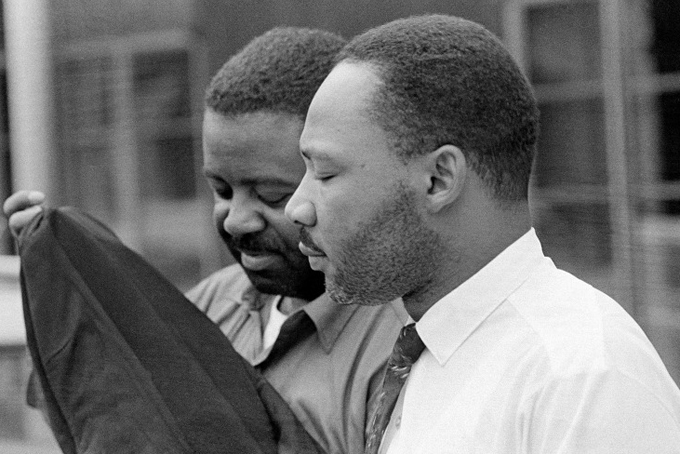
FREE AT LAST–Martin Luther King and Ralph Abernathy (background) leave Birmingham City Jail following their release on April 20, 1963, after eight days of imprisonment. (AP Photo)
by John Blake
(CNN) — By the time Clarence Jones reached him, the Rev. Martin Luther King Jr. was in bad shape.
He was unshaven, dirty and dejected. King had spent several days alone in solitary confinement with no mattress in a filthy dark jail cell in Birmingham, Alabama.
“Take this out of here,” King whispered as he grabbed Jones’ belt and stuffed bawled-up newspapers and toilet tissue down his pants.
Jones, King’s lawyer, wondered if King was starting to lose it. He didn’t pay attention to what King had given him — it was just a mish-mash of words and arrows scribbled on bits of paper.
“Not until five days later did I actually read a mimeographed copy of the letter,” says Jones. “To be honest with you, I was more worried about bail money, not what he had written.”
Millions of people have since read what Jones first ignored. As the nation commemorated the 50th anniversary of King’s “Letter from Birmingham Jail” on April 16, the document has become an American epistle. It’s considered a classic defense of civil disobedience.
But those who see King’s letter as just a tract on nonviolent resistance make the same mistake King’s lawyer made: They miss what’s special about something that’s right in front of their eyes, some King scholars say.
The letter is one of the most intimate snapshots of a King most people don’t know: An angry black man who once hated white people and, according to one scholar, was more dangerous than Malcolm X, a man King admired.
“Before everything else, (the letter) is a Black man’s cry of pain, anger and defiance,” says Jonathan Rieder, author of the just-released “Gospel of Freedom,” which looks at the “furious truth teller” revealed in King’s classic letter.
King’s blackness — his fierce racial pride, his distinctively Black Christian faith and his belief that most whites were “unconscious racists” — is on full display in his letter, scholars say. The anger that drove King’s letter would become more prominent in the speeches King gave until, literally, his last hours, Rieder says.
“If there was a YouTube in 1968 and some of King’s sermons would have been captured, he would have been seen as a Jeremiah Wright,” says Rieder, invoking the name of President Obama’s fiery former pastor.
Rieder says King’s dual nature — the “crossover King” with the refined, professorial manner, and the private, even sarcastic King — take turns on center stage in the letter.
Around trusted friends, King was a man who smoked cigarettes, cracked people up with his impersonations of pompous black preachers, and once abruptly ended a meeting by telling his staff as he headed to a concert: “I’m sorry, y’all, James Brown is on. I’m gone.”
“King was a bad-ass,” says Rieder, a sociology professor at Barnard College in New York who spent a decade listening to King’s private and public recordings. Rieder also wrote, “The Word of the Lord is Upon Me,” a book that revealed King’s backstage discussions with friends and colleagues.
Yet the “crossover King” — the man who never embraced black separatism or abandoned nonviolence — is just as authentic, Rieder says, and his moral passion has inspired nonviolence activism around the globe.
“King’s words — the bristling at those who tell the oppressed to ‘wait for a more convenient season’ … has resonated among freedom fighters long after the ‘Letter’ was written,” Rieder writes in “Gospel of Freedom.”
Jones, the lawyer who smuggled the letter for King, stopped wondering about King’s emotional stability after he sat down to read a typed-up version of King’s notes.
Jones had given King’s notes to a 17-year-old secretary at the Southern Christian Leadership Conference, the organization King led. The secretary deciphered King’s scrawl and produced the written version. (She complained that King could preach, but his handwritten notes sure were hard to follow.)
“When I read it, I said, ‘Oh my God, it’s a masterpiece,” says Jones, author of the 2011 book, “Behind the Dream: The Making of the Speech that Transformed America.”
“He didn’t have a book around him. He did this all out of his head. With all due respect to many things he’s written, including the ‘I Have a Dream’ speech, the letter is one of the most profound (examples of) literature created in the 20th century,” says Jones, who helped write King’s “Dream” speech. Today Jones is a visiting professor at Stanford University’s Martin Luther King Jr. Research and Education Institute in California.
King’s letter, though, didn’t receive much attention when it was published by the Quakers as a pamphlet in May. It did not produce a breakthrough moment in King’s campaign against segregation in Birmingham — that moment came when the Rev. James Bevel, one of King’s lieutenants, suggested using children as demonstrators — and was initially ignored by the local and national press.
But in summer 1963, the letter started to gain traction, appearing in the Christian Century, Atlantic Monthly and Saturday Evening Post magazines. Rieder says it gained its widest audience as a chapter in King’s popular 1964 book, “Why We Can’t Wait.”
One minister was so inspired by reading King’s letter in the Christian Century that he wrote, “If the canon of the Holy Scripture were not closed, I would nominate it … as an addition to the Epistles in the best tradition of the Pauline prison letters.”
The clergymen King addressed in his letter had a more mixed reaction, Rieder wrote in his book. Some thought it worsened racial tensions, while another called it a “vicious document” and complained that he received letters throughout his life asking if he was still a bigot.